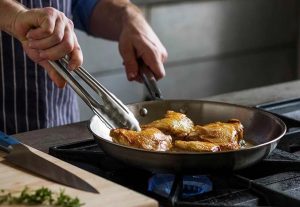The humble fry pan is a versatile tool that has been a staple in kitchens worldwide for centuries. From searing a juicy steak to sauteing vegetables, this trusty cookware offers endless possibilities for creating delicious meals. And this article will explore the various techniques and methods employed to unleash the full potential of your frying pan.
Below are the hints and techniques that will help you elevate your culinary skills and take your dishes to new heights:
- Choosing the Right Pan
The first step in unlocking your pan’s potential is choosing the right one for the job. Pans come in various materials, including stainless steel, cast iron, and non-stick coatings. Each material has its unique properties and advantages. Stainless steel pans are durable and provide excellent heat distribution, making them ideal for searing and browning foods. Meanwhile, non-stick pans are great for sauteing delicate ingredients and require less oil for cooking.
- Preheating the Pan
Preheating the pan is crucial in achieving the desired results when searing or sauteing. Preheating the pan ensures that the cooking surface is evenly heated, allowing for a proper sear or saute. And to preheat the pan, place it for a few minutes over medium-high heat until it becomes hot. You can test if the pan is ready by gently misting the surface with a few drops of water. And if the water instantly sizzles and evaporates, the pan is appropriately preheated and ready to use. Remember, a hot pan is essential for developing your dishes’ coveted flavours and textures.
- Searing to Perfection
Searing is used to create a flavorful crust on meats, fish, and even vegetables, and to achieve the perfect sear, follow these steps:
Firstly, ensure that the food you are searing is dry. Excess moisture on the surface can inhibit the browning process. Next, season your ingredients with salt and pepper or any desired spices. A tiny amount of oil with a high smoke point, such as vegetable oil, should be added to the hot pan. Now, place the food in the heated pan carefully, being careful not to crowd it.
- Mastering the Art of Sauteing
Small, uniform-sized bits of food are cooked quickly and effectively by sautéing in a frying pan over medium or high heat. For veggies, shellfish, and thinly cut meats, this technique works well. So, preheat the pan and add a small bit of butter or oil to sauté like a master. Add your ingredients to the pan once the oil is heated, and keep stirring or tossing them to ensure even frying. The key to successful sauteing is maintaining high heat while keeping the ingredients in constant motion. This helps to cook the food quickly while preserving its natural flavours, colours and textures.
- Deglazing and Building Sauces
One of the advantages of using a pan is the opportunity to deglaze the pan and create flavourful sauces to accompany your dishes. Deglazing involves adding a liquid, such as broth, wine, or vinegar, to the hot pan after sauteing. This helps to loosen and dissolve the browned food stuck to the bottom of the pan, known as the fond. These browned bits are packed with flavour and can elevate the taste of your sauces. And to deglaze the pan, remove the sauteed ingredients and set them aside.
The frying pan is a versatile kitchen tool that enables you to use your culinary creativity. From searing mouthwatering steaks to sauteing vibrant vegetables, the possibilities are endless. And by choosing the right pan, preheating it properly, and mastering the techniques of searing and sauteing, you can create dishes bursting with flavour, texture, and visual appeal.







